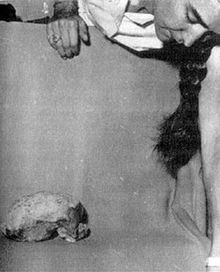2 Answers
History

The finding of a human skull which is estimated to date back to around 40,000 years ago in Niah Caves, Sarawak. It has been identified as the earliest evidence of human settlement in Malaysian Borneo.[28]
Evidence of modern human habitation in Malaysia dates back 40,000 years.[29] In the Malay Peninsular, the first inhabitants are thought to be Negritos.[30] Traders and settlers from India and China arrived as early as the 1st century AD, establishing trading ports and coastal towns in the 2nd and 3rd centuries. Their presence resulted in strong Indian and Chinese influence on the local cultures, and the people of the Malay Peninsula adopted the religions of Hinduism and Buddhism. Sanskrit inscriptions appear as early as the 4th or 5th century.[31] The Kingdom of Langkasuka arose around the 2nd century in the northern area of the Malay Peninsula, lasting until about the 15th century.[24] Between the 7th and 13th centuries, much of the southern Malay Peninsula was part of the maritime Srivijayaempire. After the fall of Srivijaya, the Majapahit empire had influence over most of Peninsular Malaysia and the Malay Archipelago.[32]Islam began to spread among Malays in the 14th century.[3] In the early 15th century, Parameswara, a prince of the former Srivijayan empire, founded the Malacca Sultanate, commonly considered the first independent state in the peninsula area.[33] Malacca was an important commercial centre during this time, attracting trade from around the region.

A Famosa fortress in Malacca was built by the Portuguese in the 16th century.
In 1511 Malacca was conquered by Portugal,[3] after which it was taken by the Dutch in 1641. In 1786 the British Empire established a presence in Malaya, when the Sultan of Kedah leased Penang to the British East India Company. The British obtained the town ofSingapore in 1819,[34] and in 1824 took control of Malacca following the Anglo-Dutch Treaty. By 1826 the British directly controlled Penang, Malacca, Singapore, and the island of Labuan, which they established as the crown colony of the Straits Settlements. By the 20th century, the states of Pahang, Selangor, Perak, and Negeri Sembilan, known together as the Federated Malay States, had British Residents appointed to advise the Malay rulers, to whom the rulers were bound to defer by treaty.[35] The remaining five states in the peninsula, known as the Unfederated Malay States, while not directly under British rule, also accepted British advisers around the turn of the 20th century. Development on the Peninsula and Borneo were generally separate until the 19th century. Under British rule the immigration of Chinese and Indians to serve as labourers was encouraged.[36] The area that is now Sabah came under British control as North Borneo when both the Sultan of Brunei and theSultan of Sulu transferred their respective territorial rights of ownership, between 1877 and 1878.[37] In 1842, Sarawak was ceded by the Sultan of Brunei to James Brooke, whose successors ruled as the White Rajahs over an independent kingdom until 1946, when it became a Crown colony.[38]
In the Second World War the Japanese army invaded and occupied Malaya, North Borneo, Sarawak, and Singapore for over three years. During this time, ethnic tensions were raised and nationalism grew.[39] Popular support for independence increased after Malaya was reconquered by Allied Forces.[40] Post-war British plans to unite the administration of Malaya under a single crown colony called the Malayan Union met with strong opposition from the Malays, who opposed the weakening of the Malay rulers and the granting of citizenship to the ethnic Chinese. The Malayan Union, established in 1946 and consisting of all the British possessions in the Malay Peninsula with the exception of Singapore, was quickly dissolved and replaced by the Federation of Malaya, which restored the autonomy of the rulers of the Malay states under British protection.[41] During this time, mostly Chinese rebels under the leadership of the Malayan Communist Party launched guerrilla operations designed to force the British out of Malaya. The Malayan Emergency lasted from 1948 to 1960, and involved a long anti-insurgency campaign by Commonwealth troops in Malaya.[42] After this a plan was put in place to federate Malaya with the crown colonies of North Borneo (which joined as Sabah), Sarawak, and Singapore. The proposed date of federation was 31 August 1963, however, the date was delayed until 16 September 1963 due to opposition from Indonesia's Sukarno and the Sarawak United Peoples' Party.[43]

The Sultan Abdul Samad Building, which was built during the British administration. In front of this building is where Malaysia Dayis celebrated annually on 16 September.
Federation brought heightened tensions including a conflict with Indonesia, Singapore's eventual exit in 1965,[44][45] and racial strife. This strife culminated in the 13 May race riots in 1969.[46] After the riots, the controversial New Economic Policy was launched by Prime Minister Tun Abdul Razak, trying to increase the share of the economy held by the bumiputera.[47] Under Prime Minister Mahathir Mohamad there was a period of rapid economic growth and urbanisation beginning in the 1980s. The economy shifted from being agriculturally based to one based on manufacturing and industry. Numerous mega-projects were completed, such as the Petronas Towers, the North-South Expressway, the Multimedia Super Corridor, and the new federal administrative capital of Putrajaya.[26]However, in the late 1990s the Asian financial crisis almost caused the collapse of the currency and the stock and property markets.[48]
http://en.wikipedia.org/wiki/Malaysia
| 11 years ago. Rating: 4 | |
in my histry book and my grand father also a freedom fighter so i took from him the histry of our cuntry
| 11 years ago. Rating: 2 | |
____________________________
 veysley
veysleyalso in war our religion is fighting to our freedom we should thanks to their

 veysley
veysley
 Colleen
Colleen
 Best answer!
Best answer!
 archan*
archan*




